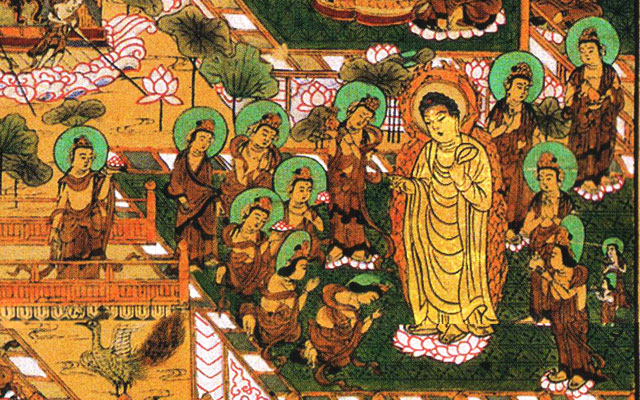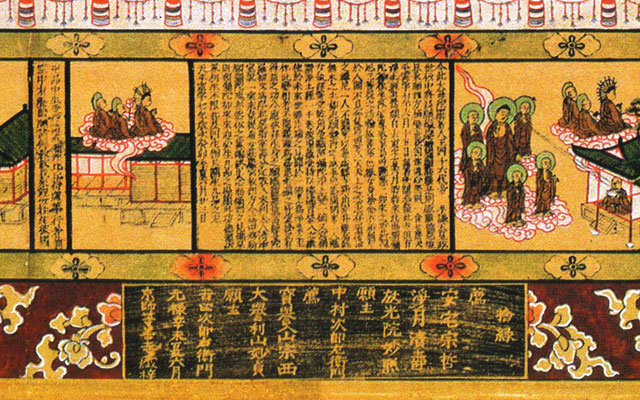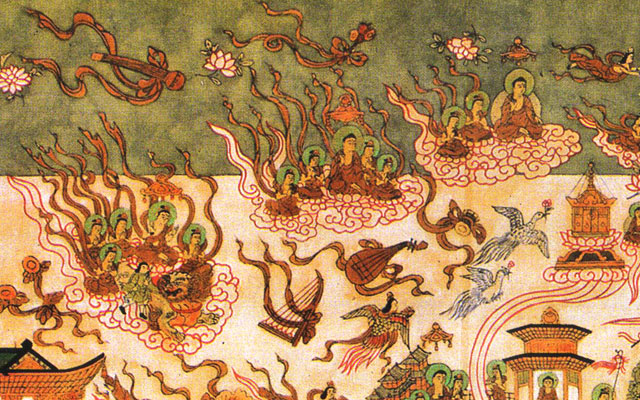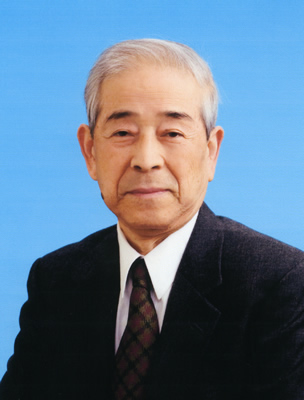
The origin
According to tradition, Chujo no Tsubone, the daughter of a nobleman Yokohagino Dainagon, lost her mother, and so aspired to the Pure Land where she should have been born. In 763 she became a nun at the Taima-dera, Nara Prefecture, and received the Dharma name Honyo ("Dharma-suchness"). Wishing to envision Amida, she began a seven-day meditation on him. On the sixth day a nun appeared and instructed Honyo to gather a hundred horseloads of lotus-stems. When this was done in three days with the help of her father, the nun appeared again and span the lotus fibers into thread. When she had dyed the threads in the five Buddhist colors, another nun appeared and wove them into a Pure Land mandala overnight. Honyo was greatly rejoiced to see this, and asked their names. The first nun said that she was an incarnation of Amida and the second nun, Kannon (Avalokiteshvara). Since then, Honyo diligently contemplated this mandala, and successfully attained birth in the Pure Land in 775.
Transmission
This mandala became popular after the 13th century. Shoku (1177-1247), a disciple of Honen and the founder of the Seizan school of the Jodo sect, visited Taima-dera in 1229 at the request of its resident priest, Ken'a, and carefully examined the mandala. Deeply impressed by its grandeur and its precise presentation of the Contemplation Sutra in accordance with Shan-tao's (613-681) commentaries, Shoku wrote a detailed commentary, entitled Taima-mandara-chuki, 10 fasc. He had a painter make copies of the mandala and donated them to various temples and Nembutsu centers. He also had wood-blocks of it carved, which he distributed in Japan and China.
Shoku's commentary was followed by many others, including the extensive one by Shoso Yuyo (1366-1440), the eighth abbot of the Chinzei school of Jodo sect and the founder of the Zojoji temple in Tokyo. Copies of the mandala were widely used as "etoki" (explanation of the teaching by a picture) as well as objects of veneration.
Dokutan Mandala
The Taima Mandala in the late Mr. Harold Stewart's possession is a hanging scroll of a wood-block print, measuring 111 by 90.5 cm., painted in pale gold and delicate colors. On the bottom it bears the names of the donors and the date, "the 4th year of Genroku" (1691). What is special about this mandala is that in the upper margin it bears two Chinese hymns composed by Dokutan (1628-1706), a Chinese native who came to Japan with Ingen, the founder of the Obaku school of the Zen sect, and became the fourth abbot of the Manpukuji at Uji. Obaku school is a later development of Zen and is noted for its close connection with the Nembutsu teaching. Dokutan was fascinated by the Taima Mandala and made a great effort to popularize it by printing many copies. This type of the Taima Mandala is especially called "the Dokutan Mandala."
Harold Frederick Stewart

The Australian poet Harold Frederick Stewart (1916-1995), who lived in Japan for the last twenty-nine years of his life, was the most important Buddhist writer that Australia has produced.
More info
A vignette of his life and works
Harold Stewart: An Early Australian Buddhist

















